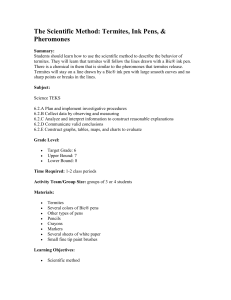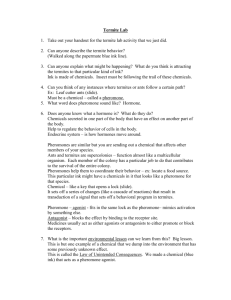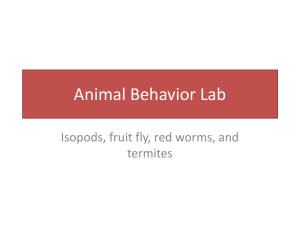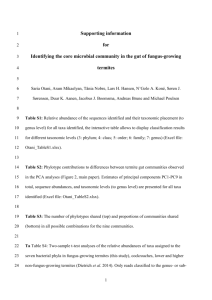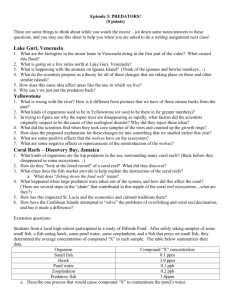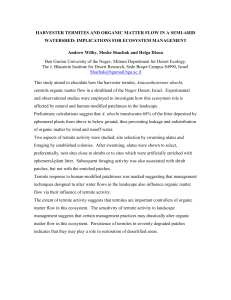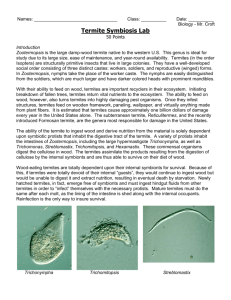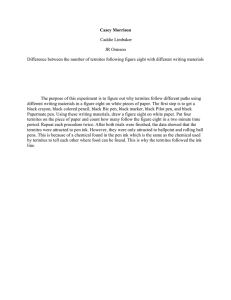Termites, ink pens and pheromones
advertisement
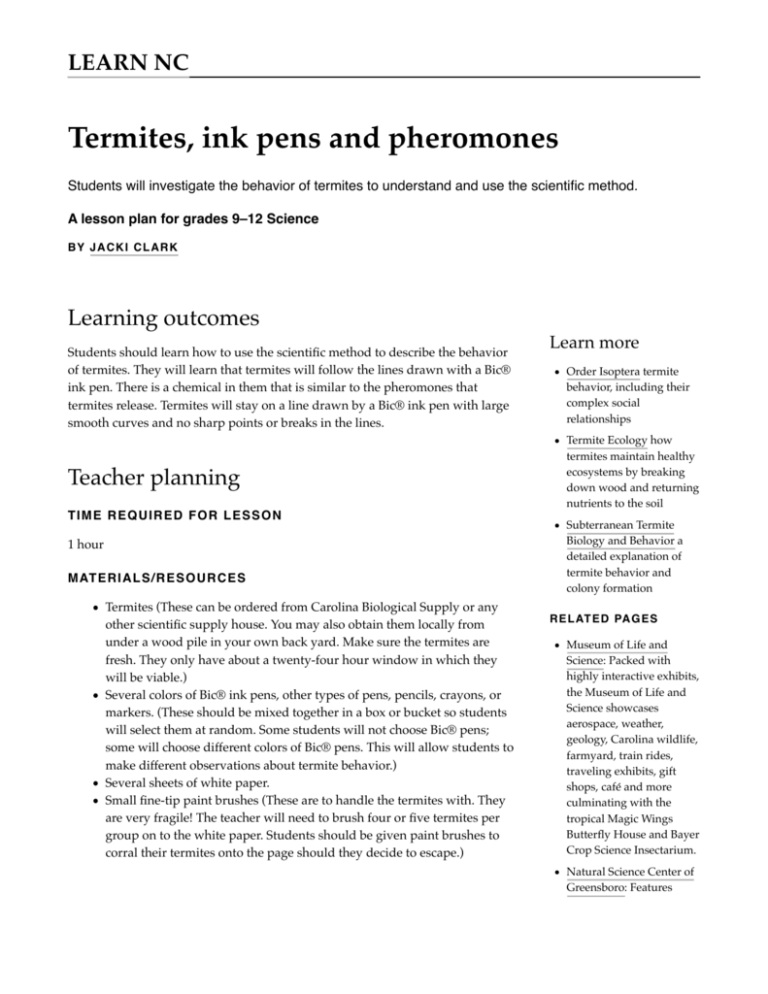
LEARN NC Termites, ink pens and pheromones Students will investigate the behavior of termites to understand and use the scientific method. A lesson plan for grades 9–12 Science BY JA CKI CL AR K Learning outcomes Students should learn how to use the scientific method to describe the behavior of termites. They will learn that termites will follow the lines drawn with a Bic® ink pen. There is a chemical in them that is similar to the pheromones that termites release. Termites will stay on a line drawn by a Bic® ink pen with large smooth curves and no sharp points or breaks in the lines. Teacher planning TIM E RE QUIRE D FOR LESS ON 1 hour MAT ERIA LS /R E S OU R C E S Termites (These can be ordered from Carolina Biological Supply or any other scientific supply house. You may also obtain them locally from under a wood pile in your own back yard. Make sure the termites are fresh. They only have about a twenty-four hour window in which they will be viable.) Several colors of Bic® ink pens, other types of pens, pencils, crayons, or markers. (These should be mixed together in a box or bucket so students will select them at random. Some students will not choose Bic® pens; some will choose different colors of Bic® pens. This will allow students to make different observations about termite behavior.) Several sheets of white paper. Small fine-tip paint brushes (These are to handle the termites with. They are very fragile! The teacher will need to brush four or five termites per group on to the white paper. Students should be given paint brushes to corral their termites onto the page should they decide to escape.) Learn more Order Isoptera termite behavior, including their complex social relationships Termite Ecology how termites maintain healthy ecosystems by breaking down wood and returning nutrients to the soil Subterranean Termite Biology and Behavior a detailed explanation of termite behavior and colony formation R ELATE D PA GES Museum of Life and Science: Packed with highly interactive exhibits, the Museum of Life and Science showcases aerospace, weather, geology, Carolina wildlife, farmyard, train rides, traveling exhibits, gift shops, café and more culminating with the tropical Magic Wings Butterfly House and Bayer Crop Science Insectarium. Natural Science Center of Greensboro: Features Pre-activities You may want to define the terms of the scientific method prior to the lesson. This would include: hypothesis, prediction, data, inference, experimentation, and conclusion. I like to use this with no introduction at all and just let the students experiment. Then I define the terms after the lab. Activities 1. Teacher divides students into groups of three or four. 2. Teacher distributes several sheets of paper to each group. 3. Allow one student per group to come and select various writing instruments from a box or bucket at the front of the room. You may want to have a variety of pencils and pens banded together and simply pass these out to the groups. 4. Distribute paint brushes. 5. Prior to distributing the termites, tell students how fragile they are and that they will be observing termite behavior today. Tell them to watch the termites as they crawl on the paper and try drawing on the paper to see if this affects their behavior. Tell them you will be stopping them in a few minutes to discuss their observations. 6. Distribute the termites and let the learning begin! 7. Give the students five minutes or so to observe termite behavior. 8. Allow the groups to tell you their observations as you list them on the board. Some students will say that termites will follow red pens. This is because they only have a red Bic® pen. Others will say they do not follow red pens because their red pen is not a Bic®. Write all observations on the board. 9. Tell students to test one of the hypotheses. They need to have a control group and experimental group. You also need to explain to them that they must also test only one thing at a time in order to get clear data. 10. Give students five minutes or so to experiment. 11. Collect data again and continue to have students complete this process until they realize that it is the Bic® pens that the termites will follow. Assessment After the discovery, review the steps of the scientific method and apply what the students just did to the vocabulary. I usually do this in an informal discussion the first day. Students’ progress can be assessed using a rubric. North Carolina Curriculum Alignment SC IENC E (2005) hands-on exhibits, a zoo, and a planetarium as well as a dinosaur exhibit and a Gem and Mineral Gallery. Camp Don Lee: Check out the programs available to classroom students at this beautiful camp located near Arapahoe, North Carolina. R ELATE D TO P ICS Learn more about biology, hypothesis, insects, observation, science, scientific method, termites, and variables. Help Please read our disclaimer for lesson plans. Legal This page copyright ©2008. Terms of use Grades 9–12 — Advanced Placement Biology Goal 1: The learner will develop abilities necessary to do and understand scientific inquiry. Objective 1.01: Identify questions and create hypotheses that can be answered through scientific investigations. Objective 1.02: Design and conduct scientific investigations to answer biological questions. Create testable hypotheses. Identify variables. Use a control or comparison group when appropriate. Select and use appropriate measurement tools. Collect and record data. Organize data into charts and graphs. Analyze and interpret data. Communicate findings. Objective 1.03: Formulate and revise scientific explanations and models using logic and evidence to: Explain observations. Make inferences and predictions. Explain the relationship between evidence and explanation. Goal 6: The learner will develop an understanding of the unity and diversity of life. Objective 6.05: Examine the structure and function of plants and animals. Analyze reproduction, growth, and development. Patterns Adaptations (e.g. alternation of generations). Regulation as by hormones. Recommended laboratory - Transpiration Analyze structural, physiological, and behavioral adaptations. Cell level. Tissue level. Organ level. Interactions between levels of organization. Recommended laboratories - Physiology of the Circulatory System, Animal Behavior Identify responses to the environment. Grades 9–12 — Biology Goal 1: The learner will develop abilities necessary to do and understand scientific inquiry. Objective 1.01: Identify biological questions and problems that can be answered through scientific investigations. Objective 1.02: Design and conduct scientific investigations to answer biological questions. Create testable hypotheses Identify variables. Use a control or comparison group when appropriate. Select and use appropriate measurement tools. Collect and record data. Organize data into charts and graphs. Analyze and interpret data. Communicate findings. Objective 1.03: Formulate and revise scientific explanations and models of biological phenomena using logic and evidence to: Explain observations. Make inferences and predictions. Explain the relationship between evidence and explanation. LEARN NC, a program of the University of North Carolina at Chapel Hill School of Education, finds the most innovative and successful practices in K–12 education and makes them available to the teachers and students of North Carolina — and the world. For more great resources for K–12 teaching and learning, visit us on the web at www.learnnc.org.
